Encephalartos ghellinckii
Encephalartos ghellinckii Lem.
Family: Zamiaceae
Common names: Drakensberg cycad (Eng.); drakensbergbroodboom (Afr.); isidawu (Zul.); umguza (Xho.)
Introduction
The Drakensberg cycad should be not be confused with any other species because of its very narrow and exceptionally revolute leaflets, which are unique among the southern African cycads. There are 2 forms of Encephalartos ghellinckii, the highland or 'giant' form, which occurs at altitudes of 1 100–1 800 m in the KwaZulu-Natal Drakensberg, and the lowland or 'dwarf' form, which is widespread and is found at lower altitudes of the Drakensberg near the Umkomaas River and in the north of the Eastern Cape.
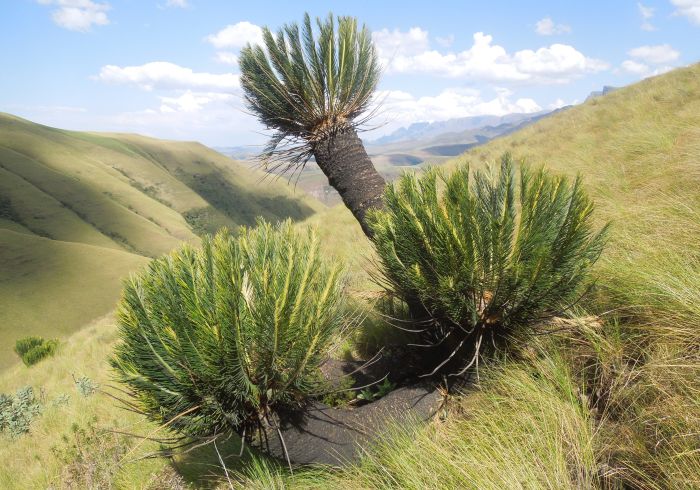
Description
Description
This is a medium-sized cycad, with an aerial, erect or reclining stem. New suckers are produced from the base, in clumps of up to 3 stems. The stems of the highland form plants can grow up to 3 m tall with a diameter of 300–400 mm. Stems of the lowland form plants in the Eastern Cape are thinner and reclining, whereas species growing in the Drakensberg grow taller. Lowland form plants rarely grow taller than 1 m and have a diameter of 250–350 mm.
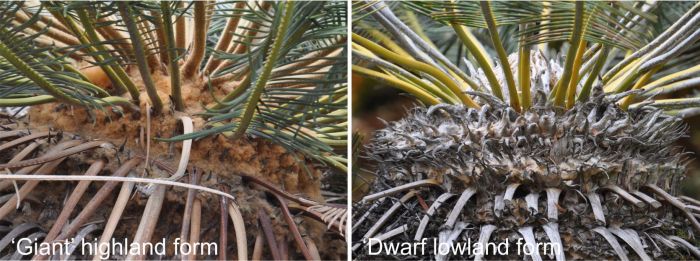
In the highland form the crown produces a large amount of golden-brown wool during coning and when new leaves appear. In the lowland form, the crown produces sequences of bracts that are covered with soft, fine hairs and there is no golden-brown wool.

The leaves are straight or inward curving, up to 1 m long, with both forms having the same leaf texture. The leaflets are dense, pointed, narrow; the margin is rolled back (revolute) and untoothed; dark green to yellow-green on the upper side and slightly paler on the lower side. The leaves of the highland form are compact, have a tidy appearance with broader, 4–5 mm leaflets and the margin is revolute. The median leaflets touch but do not overlap. New leaves are covered with golden-brown hairs, which persist until mature.
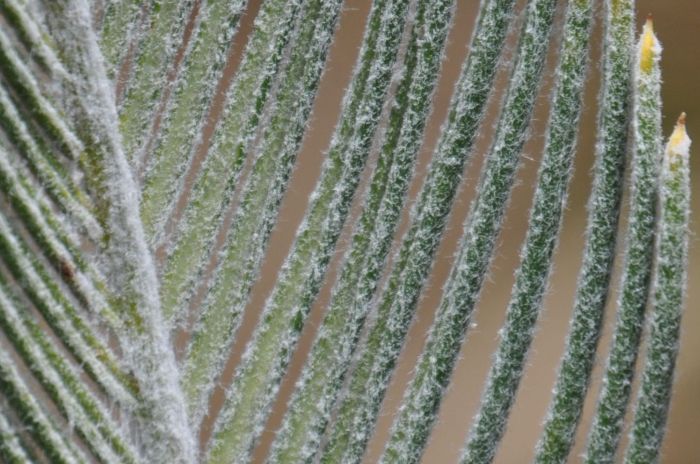
The leaves of the lowland form have an open, untidy appearance and are twisted near the apex. The leaflets are 2–3 mm broad. There is space between median leaflets. New leaves are covered with white wool, which disappears as the leaf matures. The basal leaflets are reduced to 1 or 2 spines.
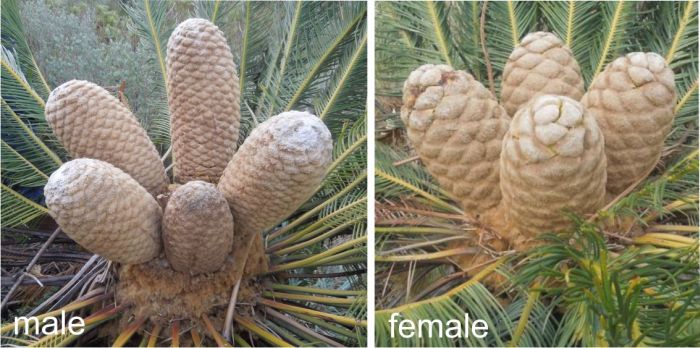
Both female and male plants produce 1–5 cones per crown. They appear to be sessile because their peduncles are short and densely covered with wool. The cones have a dense, everlasting, yellow, outer woolly layer. Male cones are pale yellow, 250–300 mm tall and 60–80 mm in diameter and pollen shedding takes place in early summer (November). Female cones are yellowish, 200–250 mm tall and 120–150 mm in diameter, barrel-shaped and rounded on top. The cones of the lowland form are smaller. Seeds are yellow to golden-yellow.
Young plants of this cycad may be confused with Encephalartos cycadifolius, the latter occurs in the Eastern Cape and in this species the leaf is not revolute, and the rachis eventually turns bright yellow and curves gradually upwards.

Conservation Status
Status
According to the Red List of South African plants website, this species is assessed as Vulnerable (VU). According to records, the remaining population size is estimated at less than 10 000 mature individuals and several subpopulations are declining. Subpopulations of the ‘lowland' form are more threatened and may be on the brink of extinction because of poaching, however, the ‘highland' form grows in a very inhospitable habitat that is less accessible, and is thus at lower risk. The greatest threat is the removal of cycads from the wild, it is estimated that over 10% of the remaining plants could be gone within the next 30 years.

Distribution and habitat
Distribution description
This species is found in KwaZulu-Natal and the Eastern Cape. Both forms of this species grow on steep, grassy slopes and on rocky outcrops in full sun. Usually the large plants can be found hanging over the edge of cliffs overlooking a deep gorge. This cycad prefers growing in full sun on east-facing slopes. The altitude range is from 700 m in KwaZulu-Natal to about 2 400 m in the Drakensberg Mountains. The climate is mild to hot in summer and very cold with severe frost and snow in winter.

Derivation of name and historical aspects
History
The genus Encephalartos was described by the German botanist Johann Georg Christian Lehmann in 1834. The epithet is derived from Greek and means ‘bread in head’ and refers to the floury, starchy material in the trunks of some species, which is used as famine food by local people. This species was described in 1867 by C.H. Lemaire. The specific epithet ghellinckii is in honour of Edward de Ghellinck de Walle, an amateur botanist with a fine private collection in Ghent, Belgium.
Cycads are grouped into 3 families: Cycadaceae, Stangeriaceae and Zamiaceae. Currently there are about 343 cycads recognized worldwide. Cycads are found in the tropical, subtropical and warm temperate regions of Africa, Asia, Australia, and North, and Central America. South Africa has the most cycad species in Africa, with 38 species of cycads, all in the genus Encephalartos of the family Zamiaceae, and one Stangeria. South Africa also has the most threatened species: 3 species are Extinct in the Wild (EW) and 12 species have been listed as Critically Endangered (CR), and likely to soon be extinct in the wild.

Ecology
Ecology
Encephalartos ghellinckii occurs in grassland and grassfires are common in this type of habitat and fire plays a very important role in the formation of cones and new leaves.
For a long time it was thought that all cycads were wind pollinated, as most coniferous plants are, and the fact that cycads generally produce high volumes of pollen, supported this argument. However, objections were raised based on the following points: species such as E. cycadifolius, E. ghellinckii, E. heenanii, E. friderici-guilielmi and E. lanatus have very woolly cones, which make it difficult for wind pollination to happen. Other cycad species such as E. villosus and Stangeria eriopus occur in forest where there is no wind. Current research shows that insects are the pollinators of all 10 cycad genera. Most cycads are thermogenic (able to produce heat) and emit volatile odours. In nature when the male cone reaches maturity, the central axis elongates and the scales move apart to make room for the release of the pollen, which is distributed by insects. The release of pollen varies between species but usually lasts for 2 weeks, on average. At the same time, the female cone also reaches maturity, the cone heats up, causing it to elongate, and it produces a smell, which attracts the insects, the pollen vectors, to the female cone. The scales move apart to allow the insects to enter and to pollinate the cone.
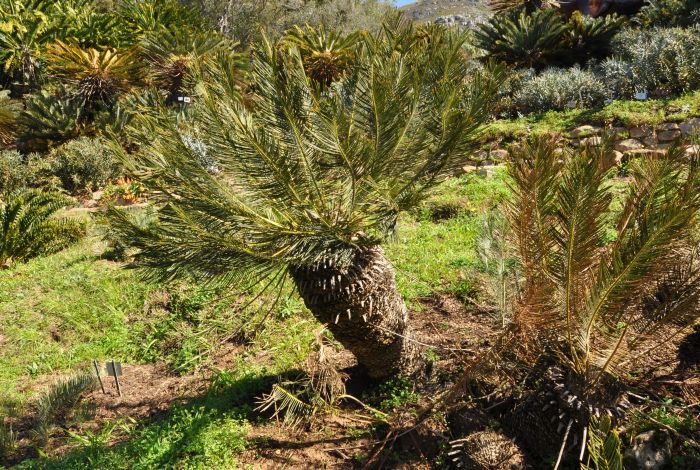
Uses
Use
The bark and stems of Encephalartos ghellinckii are used in traditional medicine and traded at muthi markets in Durban and Johannesburg. It is also traded as a garden ornamental. Both these practices are destructive and are now illegal because they are contributing to a decline in the number of wild plants, and could cause the extinction of this species in the future.
In isiZulu language, most of the cycads are referred to as isqgiki–somkhovu. This name refers to witchcraft practices, where a person is converted into becoming a zombie and is used for witchcraft. The cycad is planted in front of the gate of the homestead to protect it from the evil spirit. If someone practices any witchcraft using umkhovu, this zombie will sit on top of the cycad, which is referred as isqgiki, which means ‘chair’, and that is where the common name is derived from.

Growing Encephalartos ghellinckii
Grow
Encephalartos ghellinckii is one of the slowest growing and most difficult to re-establish after the leaves and roots have been removed during transplanting. If not removed prior to transplanting, the leaves of large specimens die shortly after transplanting. Even if successfully moved, it can take up to 5 years before producing a new set of leaves and plants in cultivation rarely produce cones. This cycad grows best on slightly acidic soil in full sun or semi shade. This species will tolerate frost and snow.
Encephalartos ghellinckii is propagated by seed and suckers. Sow seed in river sand and place on a heated bench at 24–28ºC. Germination should start 3–6 weeks after sowing. However, some seeds will take longer, especially where there is no heat.
Most cycads produce basal growths, known as pups or suckers. These are small vegetative offsets that are genetically identical to the mother plant. The best time to remove a sucker is in early spring (July–September), during the dormant period.
When a sucker reaches a size of about 80 mm diameter, dig the soil away from around the main cycad to expose the sucker and clean any dirt from the sucker and the main cycad. Use a sharp, clean, cutting tool such as a saw, chisel or knife to cut off the sucker. Make a clean cut at the point of attachment of the sucker to the main plant. As a precaution, especially with valuable species, apply fungicide, sulphur or a tree seal to the cut area, on both the sucker and the mother plant, to prevent disease and attacks by pests.
If the sucker is large enough (minimum of 250 mm) and it has enough roots, it is best to immediately plant it straight into the ground. Smaller suckers and suckers with no roots of their own must be taken to the nursery, where they should be left in a cool, dry area to dry for a few weeks, to allow the wounds to form a callus, before potting.
References
- Cousins, S.R., Williams, V.L. & Witkouwski, E.T.F. 2012. Uncovering the cycad taxa (Encephalartos species) traded for traditional medicine in Johannesburg and Durban, South Africa. South African Journal of Botany 78: 129–138.
- Goode, D. 2001. Cycads of Africa. Cycads of Africa Publishers, Gallomanor.
- Grobbelaar, N. 2002. Cycads with special reference to the southern African species. Published by the author, Pretoria.
- Jones, D.L. 1993. Cycads of the world: Ancient plants in today's landscape. Reed, New South Wales.
- Ulwazi, Sharing indigenous knowledge. Isihlahla sesigqiki somkhovu. https://www.ulwaziprogramme.org/2016/10/isihlahla-sesigqiki-somkhovu/ Accessed on 2019/01/23.
Credits
Lungisani Zondi
Walter Sisulu National Botanical Garden
March 2020
Acknowledgements: The author thanks Terence Suinyuy, Margie Herron, Lyle Ground and Geoff Nichols for allowing the use of their photos of this species growing in habitat, and Alice Notten for photos of the plants growing in Kirstenbosch NBG.
Plant Attributes:
Plant Type: Shrub, Tree
SA Distribution: Eastern Cape, KwaZulu-Natal
Soil type: Sandy, Loam
Flowering season:
PH: Acid
Flower colour:
Aspect: Full Sun, Morning Sun (Semi Shade), Afternoon Sun (Semi Shade)
Gardening skill: Challenging
Special Features:
Horticultural zones











Rate this article
Article well written and informative
Rate this plant
Is this an interesting plant?
Login to add your Comment
Back to topNot registered yet? Click here to register.